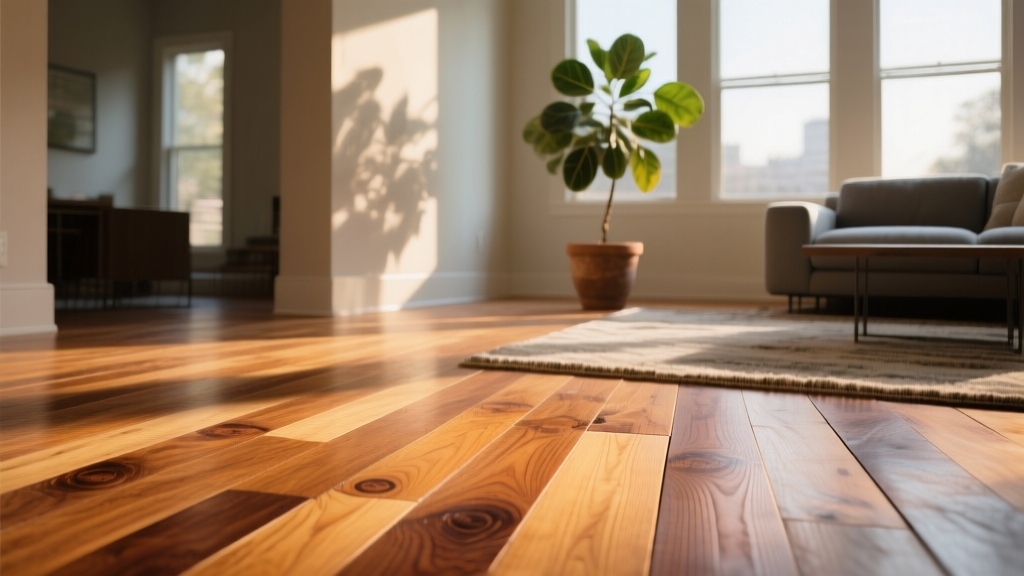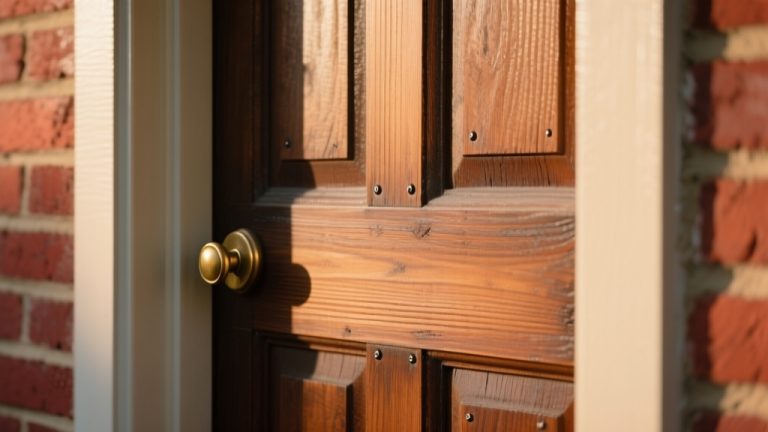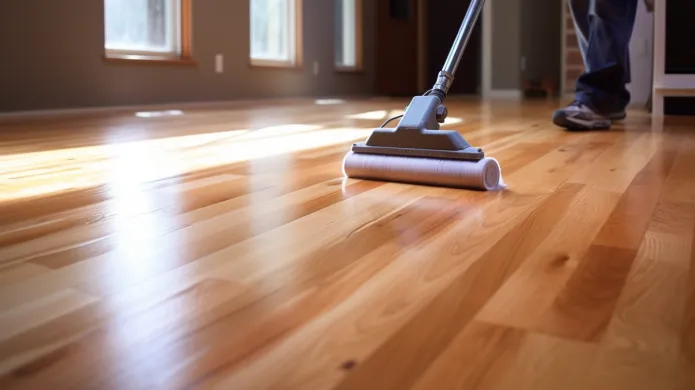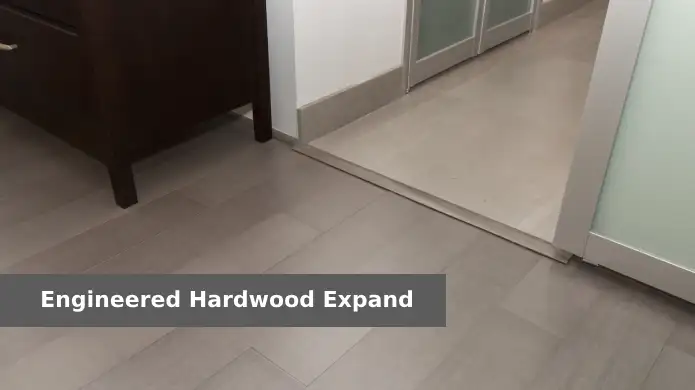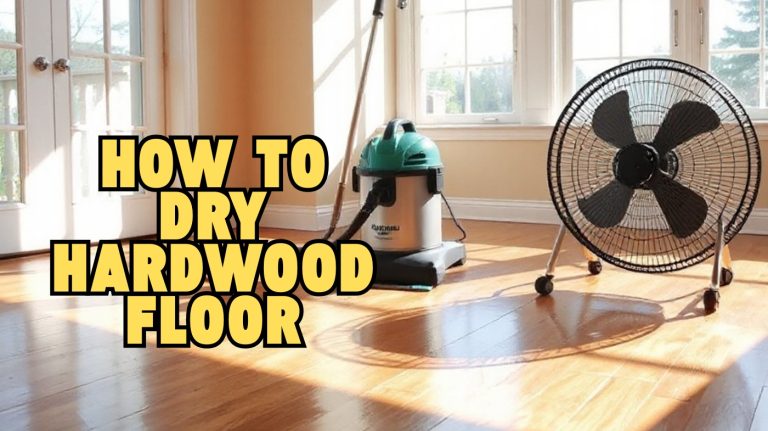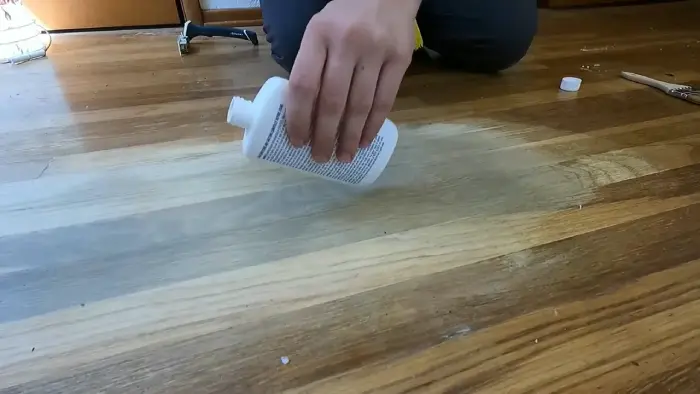Hardwood Floor Designs Ideas: Bring Warmth with Details
You can elevate your space by choosing matte or low-sheen finishes paired with wire-brushed or hand-scraped textures for natural warmth and character. Select hardwood species like oak, hickory, or maple in warm honey or caramel tones to complement your décor.
Installing wide planks in patterns like herringbone or diagonal adds depth and space perception. Opt for sustainable materials and durable coatings that resist wear while enhancing elegance. Explore deeper insights to refine your perfect hardwood floor design.
Key Takeaways
- Matte and low-sheen finishes with wire-brushed or hand-scraped textures create natural, durable hardwood floor aesthetics for 2025 trends.
- Wide plank and herringbone patterns enhance room flow and elegance, with diagonal and parquet designs adding artistic depth and visual expansion.
- Warm wood tones like honey, caramel, and golden oak complement cozy, inviting interiors and blend well with brass and neutral décor accents.
- Engineered hardwood with FSC certification and low-VOC finishes supports sustainable, eco-friendly flooring choices without sacrificing style or durability.
- Textured finishes improve scratch resistance, hide wear, increase slip safety, and reduce maintenance for long-lasting elegant hardwood floors.
Trending Finishes for Hardwood Floors in 2025
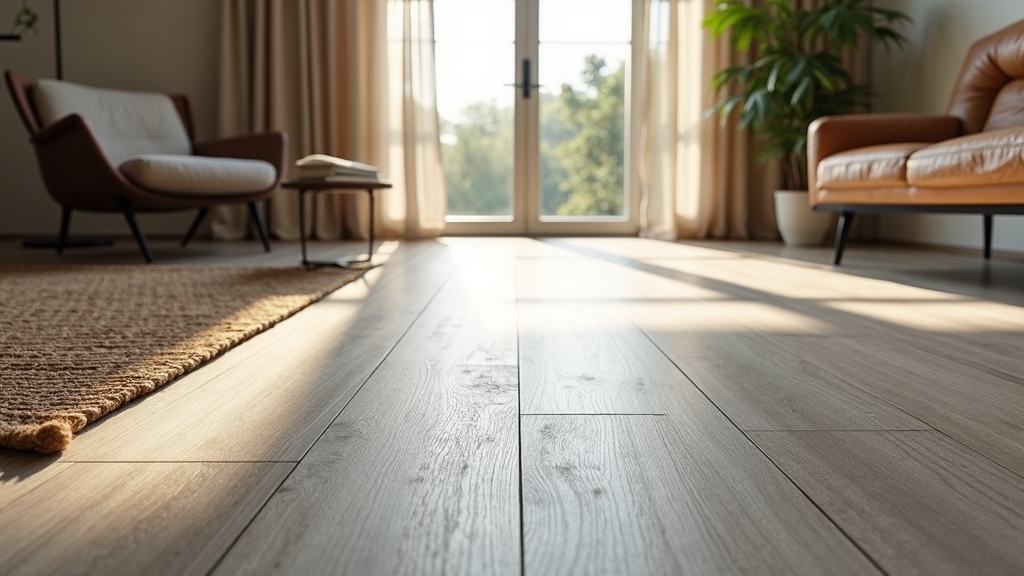
When choosing hardwood floor finishes for 2025, you’ll find that matte and low-sheen options dominate the trend, offering a refined yet natural aesthetic that minimizes glare and highlights wood’s inherent texture.
Matte finishes create a warm, inviting atmosphere by reducing reflectivity, while low-sheen variants add subtle polish without overwhelming shine. These finishes are often paired with durable coatings like Aluminum oxide to enhance scratch resistance and longevity.
Honed finishes, borrowed from stone techniques, bring a minimalist matte appeal to hardwood surfaces. Satin finishes strike a perfect balance, providing moderate luster that enhances wood grain delicately.
Beyond gloss levels, finishes like custom-mixed stains and oil-based coatings enrich wood with tailored warmth and depth.
Water-based finishes offer eco-friendly protection with a lighter touch, and varnishes safeguard while accentuating grain patterns. Choosing eco-friendly hardwood sourcing aligns perfectly with the trend towards sustainable and responsible flooring options.
These finishes complement wide plank layouts and open-concept designs, emphasizing natural beauty with technical precision.
Popular Textures That Add Character to Flooring
How can texture transform the look and feel of your hardwood floors? By selecting finishes like wire-brushed, hand-scraped, or distressed textures, you add depth and unique character.
Wire-brushed floors reveal the harder grain beneath, creating subtle ridges that balance rustic charm with sophistication while enhancing durability and slip resistance. Installing these textured floors over the right underlayment can further improve comfort and longevity.
Hand-scraped textures mimic vintage wear with tactile grooves and uneven plank thickness, delivering artisanal warmth and concealing imperfections elegantly. Distressed finishes simulate natural aging with knots and dents, enriching your space with historical appeal and hiding future wear.
Complement these textures with wide planks to amplify visual flow and highlight grain patterns, or embrace natural grain and knots to preserve authentic wood stories.
These textures blend aesthetics with function, elevating both style and resilience in your flooring. Additionally, incorporating classic patterns like herringbone can further elevate spaces with elegance and craftsmanship.
Choosing the Right Hardwood Species and Colors
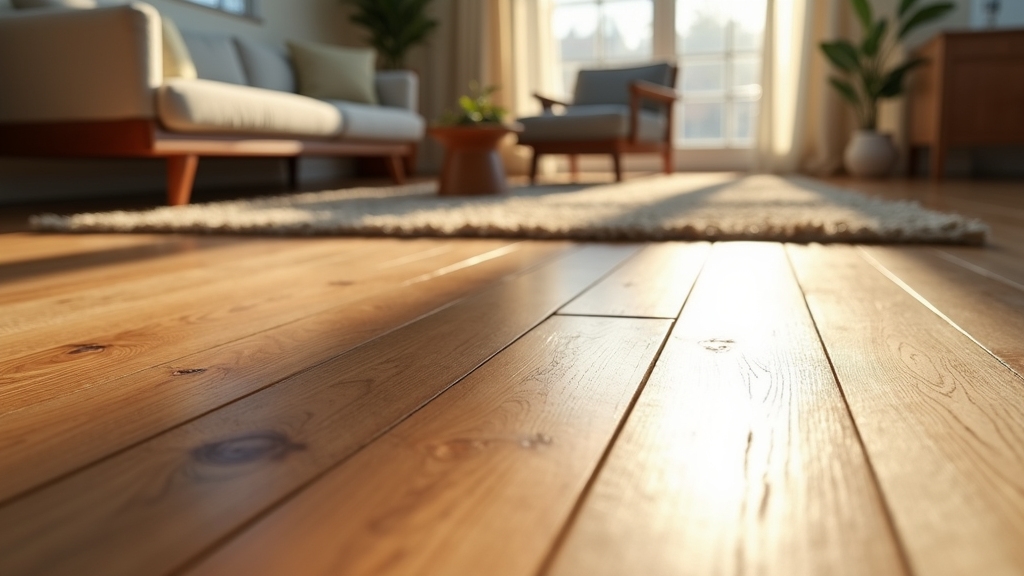
You’ll want to start by selecting hardwood species that balance durability with the visual texture you prefer, like the open grains of oak or the smoothness of maple.
Oak features visible graining and color variations that add warmth and character to floors. Trending colors range from the warm reds of traditional red oak to the pale blondes of modern maple, each influencing your room’s ambiance differently.
Matching your wood choice to your decor guarantees a cohesive style, whether you’re aiming for rustic charm with hickory or sleek minimalism with light-toned species. Consider the Janka hardness rating to ensure your flooring choice meets your durability needs for high-traffic areas.
Popular Hardwood Species
Selecting the right hardwood species is essential to achieving the perfect balance of durability, color, and grain pattern for your floors. Oak, both red and white, offers open grain with warm tones and excellent stain absorption, ideal for versatile, traditional, or rustic aesthetics. These species are also known for being durable and economical options widely available in many regions.
Hickory stands out with its extreme hardness, dramatic color contrasts, and complex grain, making it perfect for high-traffic or active spaces. Maple delivers a subtle, clean grain and pale hues, fitting minimalist and contemporary designs requiring uniformity.
For a more exotic touch, species like Acacia, Brazilian cherry, and Walnut provide dense grains and rich colors but come at higher costs and limited availability. Consider these technical traits carefully to choose a species that complements your lifestyle and design vision while ensuring lasting beauty and performance.
Trending Wood Colors
What wood colors will define hardwood flooring trends in 2025? Warm honey tones, golden oaks, chestnut, and caramel shades dominate, moving away from the cooler grays of past years. These natural, earthy hues infuse spaces with inviting warmth, enhancing both traditional and contemporary interiors.
To maintain these beautiful tones over time, avoid bleach stains which can damage hardwood floors permanently. Blonde hardwood remains popular, brightening rooms and complementing diverse décor. Blonde hardwood floors reflect Scandinavian and coastal influences, promoting a calming, spacious feel.
Deep browns and golden ambers add richness and depth, grounding larger areas with timeless elegance. Opt for matte or low-sheen finishes like UV-oiled or brushed to showcase natural grain and texture while preserving authenticity.
Choosing warm wood tones will brighten interiors, create cozy atmospheres, and harmonize with natural materials, making them a technical and aesthetic choice for lasting appeal. Honey hardwoods enhance open floor plans with natural light, emphasizing a cozy, organic aesthetic.
Matching Species to Decor
When matching hardwood species to your décor, understanding each wood’s unique grain, color, and texture is essential for creating a cohesive look.
Choose species that complement your style: oak’s pronounced grain suits traditional and modern spaces, while maple’s subtle tones fit minimalist rooms. Hickory’s color variation enhances rustic aesthetics, and walnut’s dark richness elevates elegant interiors.
Consider finishes and undertones to maintain harmony. Achieving a perfect match is often achieved by careful selection of wood species, color, grain, plank size, and layout to ensure a visually harmonious flow throughout the space.
Proper maintenance using pH-neutral cleaners helps preserve the wood’s natural beauty and finish over time.
| Species | Ideal Decor Style |
|---|---|
| Oak | Modern, Traditional |
| Maple | Minimalist, Bright Spaces |
| Hickory | Rustic, Farmhouse |
Installation Patterns That Enhance Room Aesthetics
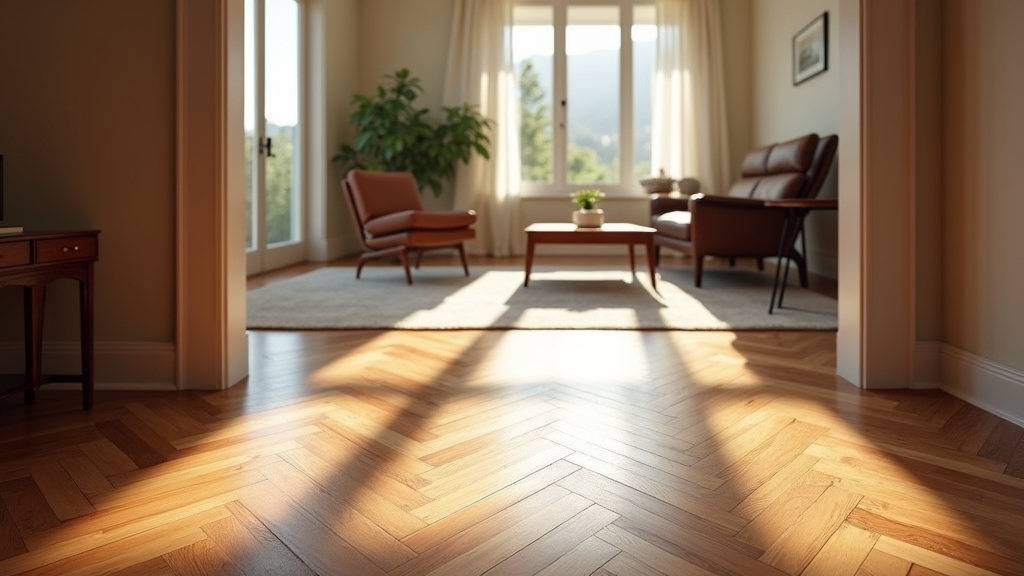
Although the choice of hardwood floor installation patterns might seem purely functional, it profoundly shapes your room’s visual flow and character. Selecting the right pattern enhances spatial perception, complements your décor, and highlights architectural features.
- Straight Pattern: Align planks parallel to the longest wall for timeless continuity and easy repairs, ideal for any style.
- Herringbone Pattern: Install zigzag planks at 90 degrees to add elegance and dynamic texture, perfect for formal spaces.
- Diagonal Pattern: Lay boards at a 45-degree angle to expand small rooms visually and create architectural interest.
- Parquet Patterns: Use geometric blocks like cubes or basketweave for artistic depth, elevating sophistication in living areas.
Each pattern demands precise cutting and layout, balancing aesthetic impact with installation complexity to suit your design goals. To maintain the beauty and longevity of these designs, regular cleaning with gentle methods is recommended to protect the hardwood surface.
Benefits of Wide Plank Hardwood Flooring
Because wide plank hardwood flooring features fewer seams and broader surfaces, it instantly enhances the perception of space in any room. The expansive boards create a seamless flow, visually stretching your space and reducing visual clutter. This type of flooring also requires professional installation to avoid issues like warping or denting.
Wide plank hardwood flooring’s broad, seamless boards visually expand any room, creating an open, clutter-free atmosphere.
This minimal seam design not only fosters spaciousness but also highlights the wood’s natural grain, knots, and color variations, turning each plank into a striking focal point. You’ll appreciate the authentic texture and warmth that wide planks bring, evoking a timeless, artisan-crafted appeal. It also maximizes the aesthetic impact of the wood’s natural features, making every floor unique.
Installation is more efficient, covering more area with fewer boards, which speeds up the process and simplifies maintenance by limiting dirt accumulation in seams. With proper acclimatization and professional installation, your wide plank floor will remain stable, durable, and elegantly spacious for years.
Integrating Hardwood Floors With Modern Interior Design
You’ll achieve seamless open-concept flow by choosing wide-plank hardwoods with minimal seams that visually expand your space. Wide-plank boards, typically ranging from 5 to 12 inches, showcase more texture and color variations than standard narrow planks.
Warm tones like rich browns or honeyed blondes add inviting coziness without sacrificing modern sleekness. Paying attention to texture and finish—matte, hand-scraped, or wire-brushed—ensures your floors complement contemporary interiors with subtle depth and organic character.
When integrating hardwood with other flooring materials, it’s important to consider floor transition strips to maintain a smooth and attractive transition.
Seamless Open-Concept Flow
When integrating hardwood floors into a modern open-concept design, maintaining a consistent tone and finish across living spaces is key to achieving visual unity and fluidity. Choose a single hardwood species with a satin or matte finish to showcase natural texture while minimizing wear visibility.
Smooth progressions between flooring materials, using subtle transition strips, help blend spaces without disrupting flow. Coordinate hardwood undertones with furniture and wall colors to harmonize décor. Prioritize durability with protective finishes and easy maintenance to keep your floors pristine in high-traffic zones.
- Use uniform hardwood species and finish throughout open areas.
- Employ curved or color-matched transition strips for seamless material shifts.
- Balance sleek floors with textured furnishings and neutral walls.
- Protect floors with durable finishes and area mats near entryways.
Additionally, ensure the existing hardwood floor is properly prepared and leveled before installing engineered hardwood to achieve a flawless, durable finish.
Warm Tones for Coziness
Building on the seamless flow of open-concept hardwood floors, incorporating warm tones elevates the room’s inviting character while maintaining modern sophistication. You’ll find that rich browns and golden hues bring depth, visual warmth, and natural texture that anchor the space.
These tones harmonize effortlessly with neutral walls and brass or dark wood accents, creating a cohesive palette that balances comfort with elegance. To optimize ambiance, consider how natural and artificial light interact with your floor’s undertones.
South-facing rooms enhance warmth, while cooler north light requires complementary accents. Warm hardwood floors also excel in biophilic design, strengthening your connection to nature and adding timeless style.
They complement biophilic design trends by connecting interiors with nature, which further enhances the overall atmosphere of your home. Additionally, selecting warm, natural tones like honey or caramel aligns with the latest trends for creating inviting and cozy interiors.
Texture and Finish Choices
Although selecting the right hardwood floor color sets the tone, choosing the appropriate texture and finish truly defines the room’s character and functionality. Your choice impacts aesthetics and durability, especially when integrating hardwood with modern interiors.
Consider these key elements:
- Texture: Smooth surfaces highlight natural grain for sleek modern looks. Wire brushed adds subtle rustic charm and hides wear, making it ideal for active homes.
- Finish: Matte finishes pair well with wire brushed textures for understated elegance. Glossy finishes brighten spaces but require more upkeep.
- Contrast: Combine dark floors with light walls for striking balance. Mix matte floors with glossy furniture to introduce textural complexity. Using contrast between wood tones creates visual interest and depth in the space.
- Eclectic layering: Blend finishes and textures to create depth. This enhances mid-century or Scandinavian designs with nuanced tactile appeal.
Sustainable and Eco-Friendly Flooring Options
Since sustainable choices shape both the environment and your living space, selecting hardwood floors from certified sustainable sources guarantees responsibility at every step. Opt for FSC-certified wood, ensuring the timber comes from forests managed with strict ecological and social standards.
Consider engineered hardwood with thin veneers over recycled cores; it reduces solid wood demand and often uses low-VOC adhesives, enhancing indoor air quality. Reclaimed wood adds unique character while supporting circular economy principles. Utilizing low-VOC finishes also helps improve indoor air quality and reduce harmful emissions.
Local sourcing minimizes transportation emissions, and plantation-grown alternatives like bamboo provide renewable options without impacting old-growth forests. Look for manufacturers using low-VOC, formaldehyde-free finishes and sustainable production practices.
These technical choices not only uphold environmental integrity but also deliver elegant, durable floors that store carbon, reduce waste, and contribute to healthier home environments.
Balancing Durability With Elegant Flooring Finishes
You’ll find durable matte finishes excel at hiding scratches and wear with their low-luster, understated elegance, perfect for busy spaces. These finishes are particularly valued for their ability to emphasize natural wood texture.
Scratch-resistant satin options strike a refined balance, offering moderate sheen that enhances wood grain while maintaining resilience. Incorporating textured flooring further masks imperfections and adds tactile depth, elevating both durability and sophisticated design.
Durable Matte Finishes
When selecting a hardwood floor finish, you want durability without sacrificing elegance, and matte finishes deliver precisely that balance. Matte finishes provide a soft, natural look with minimal shine, perfect for modern and rustic interiors.
Advanced coatings like nanotechnology-enhanced urethane offer excellent scratch and stain resistance while maintaining an ultra-matte appearance. They mask imperfections and reduce glare, creating a calm ambiance.
Matte finishes also minimize glare, enhancing the authentic look of wood surfaces. Consider these benefits when choosing durable matte finishes:
- Superior at hiding scratches, dust, and wear in busy homes
- Low maintenance—clean easily with pH-neutral hardwood products
- Factory-applied options last longer, backed by extended warranties
- Enhance wood grain naturally without artificial gloss
Scratch-Resistant Satin Options
Matte finishes offer a subdued elegance and practical durability. But if you’re aiming for a bit more sheen without sacrificing scratch resistance, satin finishes present an ideal middle ground.
Satin’s balanced luster softly reflects light, enhancing wood grain depth while masking minor scratches better than high-gloss surfaces. As a protective barrier, satin finishes shield floors from moisture and wear, significantly extending the lifespan of hardwood flooring.
Its protective coating, often fortified with aluminum oxide, boosts durability against wear and moisture, making it perfect for busy homes. You’ll appreciate satin’s easy maintenance—dust, fingerprints, and smudges show less, and routine sweeping plus damp mopping keeps it pristine.
This finish’s versatility complements styles from traditional to modern, adding warmth without glare. Satin floors also reduce refinishing frequency by concealing imperfections, giving you an elegant yet resilient hardwood option that stands up to everyday life.
Textured Flooring Benefits
Although textured hardwood flooring serves practical purposes, it also elevates your space with rich character and depth. By choosing textured finishes like wire-brushed or hand-scraped, you enhance natural grain patterns while adding tactile warmth.
Consider these key benefits:
- Conceals Wear: Texture masks scratches, dents, and pet marks, reducing visible imperfections. It is especially suitable for high-traffic areas, making it ideal for families with children and pets.
- Improved Traction: The surface offers slip resistance, increasing safety without compromising style.
- Low Maintenance: Textured floors need less frequent refinishing, extending lifespan with proper care.
- Visual Depth: Texturing adds dimension, preventing flatness and enriching your room’s ambiance.
Common Mistakes to Avoid When Selecting Hardwood Floors
Investing in hardwood floors can substantially enhance your home’s value and beauty, but selecting the right materials and installation methods demands careful attention. Avoid these common mistakes to guarantee lasting elegance and durability:
- Choose wood wisely: Opt for species suited to your climate and traffic level. Avoid softwoods like pine in busy areas and ensure engineered hardwoods have thick wear layers for refinishing.
- Acclimate and install properly: Let wood adjust to your home’s humidity before installation. Hire experienced professionals to prevent gaps, squeaks, and instability.
- Assess subfloor and environment: Confirm the subfloor is level and dry. Use vapor barriers in damp areas to prevent warping and cupping.
- Consider maintenance and warranty: Use recommended cleaning products. Maintain finishes regularly and review warranty terms to protect your investment.
Frequently Asked Questions
How Do I Maintain Hardwood Floors in High-Traffic Areas?
To maintain hardwood floors in high-traffic areas, sweep or vacuum daily to prevent grit buildup. Use a damp mop with hardwood-safe cleaner, never soaking the floor.
Protect surfaces with rugs featuring non-slip backings and felt pads under furniture legs. Choose hardwood species with high Janka ratings and apply durable finishes like polyurethane.
Regularly inspect for wear, reapply protective coatings as needed, and avoid harsh scrubbing to keep your floors looking pristine.
What Is the Average Lifespan of Hardwood Flooring?
You can expect solid hardwood floors to last 80 to 100+ years if you refinish them regularly, typically every 10 to 20 years. Without refinishing, their lifespan shortens to about 20 to 30 years.
Engineered hardwood lasts 30 to 40 years with refinishing but only 15 to 20 years without. Maintenance, wood type, finish quality, and environmental factors play essential roles in extending your flooring’s life, ensuring your space stays elegant and durable.
Can Hardwood Floors Be Installed Over Radiant Heating Systems?
Yes, you can install hardwood floors over radiant heating systems, but engineered hardwood is your best bet due to its layered stability. You’ll want to keep the surface temperature below 80°F and maintain indoor humidity between 30-50% to prevent warping.
Choose stable species like American Red Oak, and guarantee proper acclimation and subfloor prep. Using recommended adhesives and allowing expansion gaps will keep your floor both beautiful and durable over time.
How Do Humidity Levels Affect Hardwood Floor Stability?
Humidity levels directly impact hardwood floor stability by causing wood to expand or contract. When humidity rises, your floorboards absorb moisture and swell, potentially warping or cupping.
In dry conditions, they release moisture, shrinking and creating gaps. To maintain your floor’s integrity and aesthetic, keep indoor humidity between 35–55%. Use humidifiers or dehumidifiers as needed, and select flooring types that handle moisture variations better.
Are Hardwood Floors Suitable for Homes With Pets?
Yes, hardwood floors can work beautifully in homes with pets if you take precautions. You’ll want to choose harder wood species and finishes like polyurethane or BONA Traffic HD® to resist scratches.
Matte or distressed textures help mask wear, while area rugs protect high-traffic spots. Keep your pets’ nails trimmed and clean up accidents immediately to prevent stains and odors. With proper care, hardwood floors maintain elegance despite pet activity.
Refine Your Vision for the Perfect Hardwood Flooring Design
So, you’re ready to plunge into hardwood flooring, huh? Just remember, picking the perfect plank isn’t rocket science—unless you treat it like one. Skip the regrettable colors, baffling patterns, or “eco-friendly” myths without research, and you’ll be fine.
Embrace the textures, finishes, and species that actually make your space sing. After all, your floors deserve more than a DIY disaster or a dusty showroom regret. Choose wisely, and watch your rooms transform with effortless elegance.

